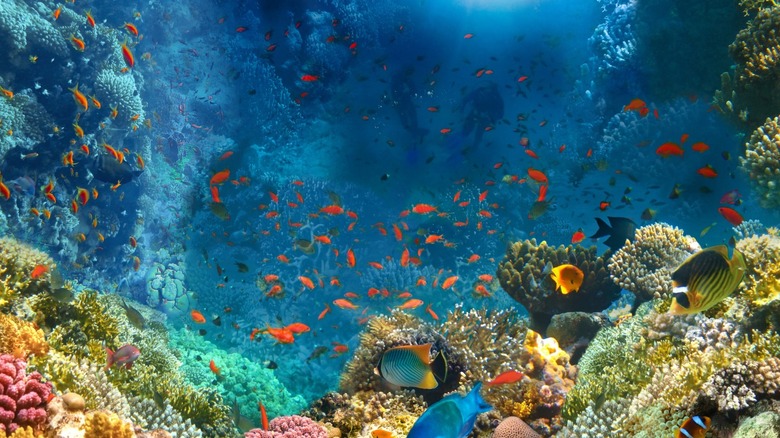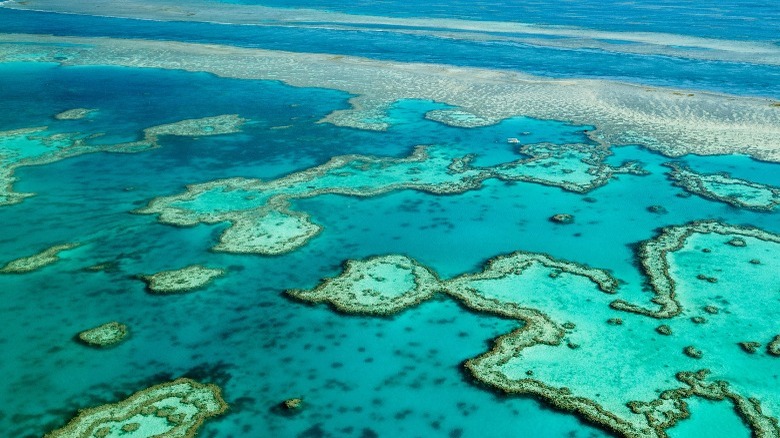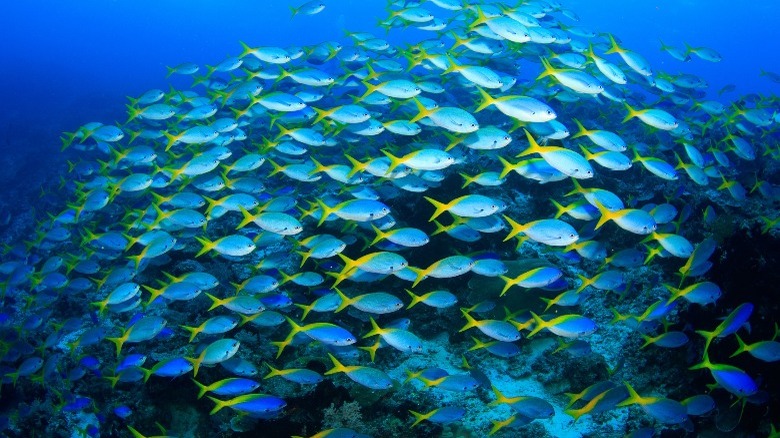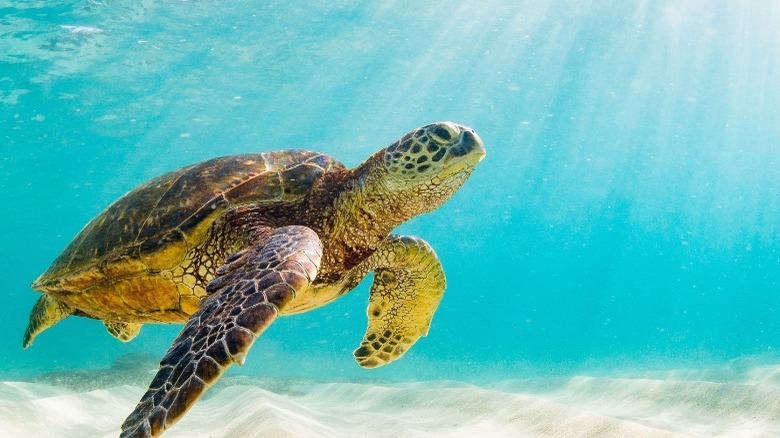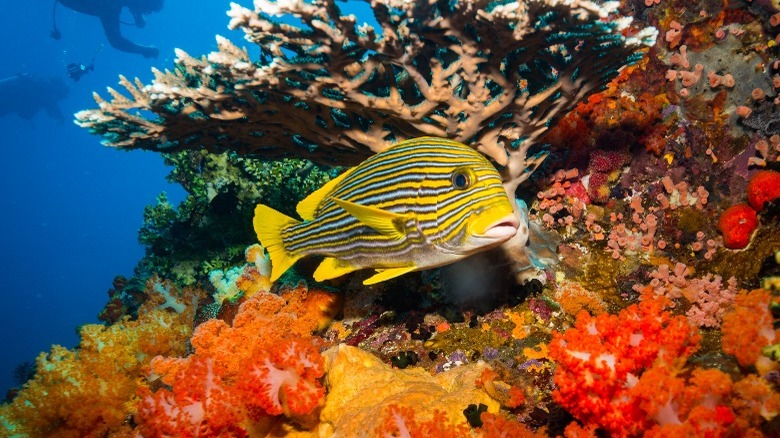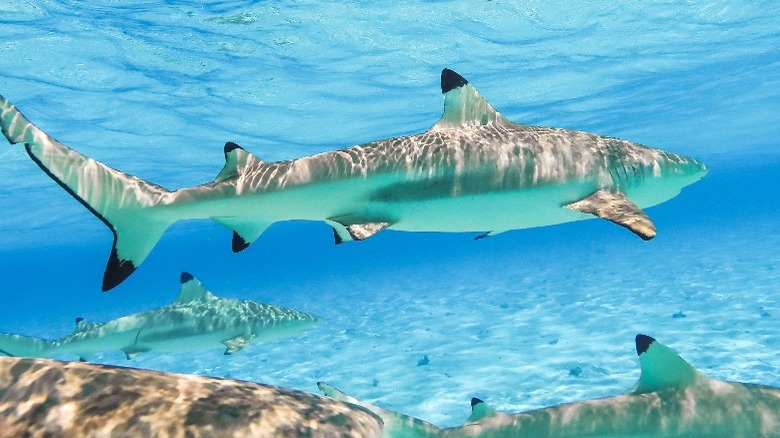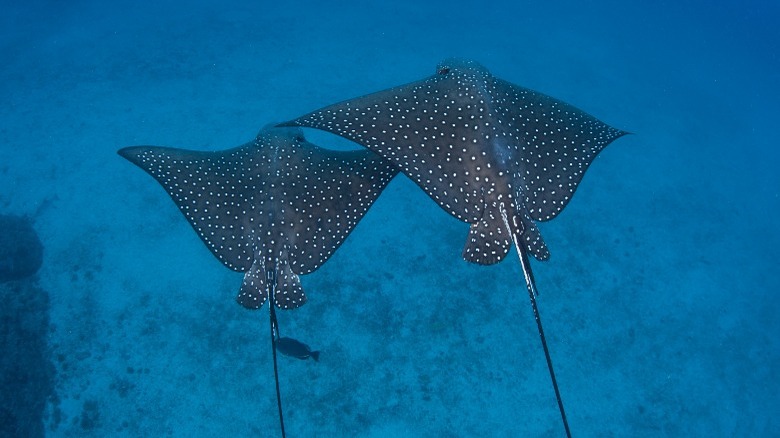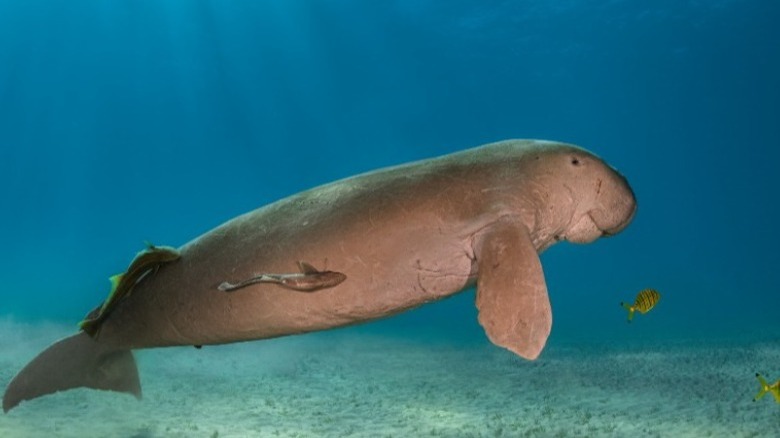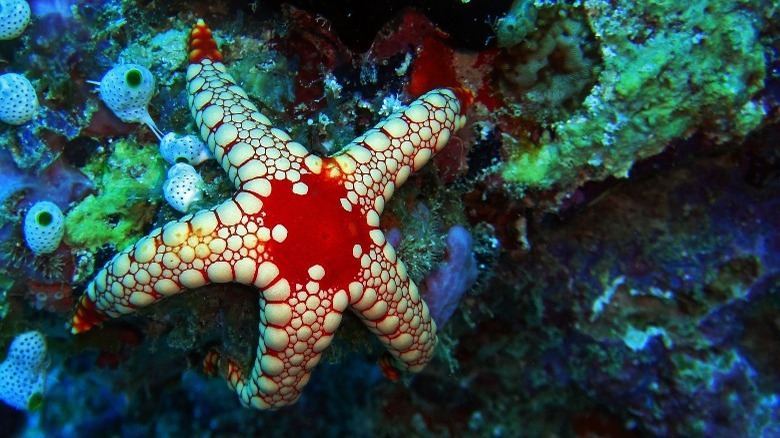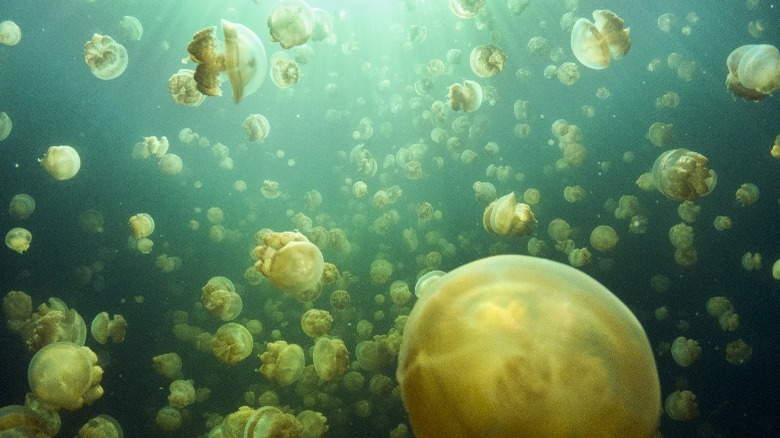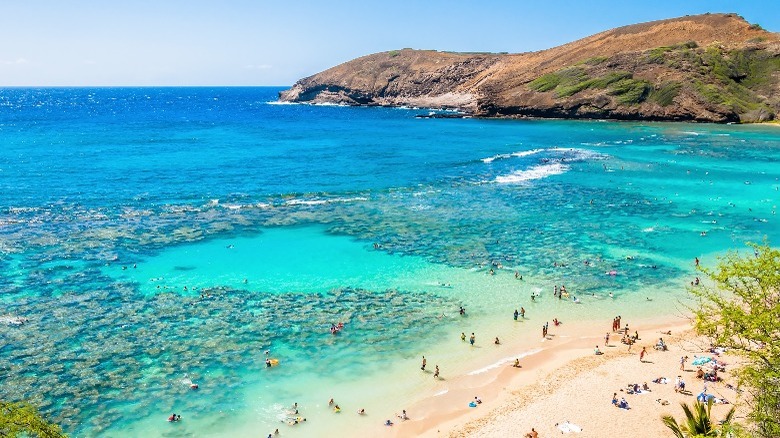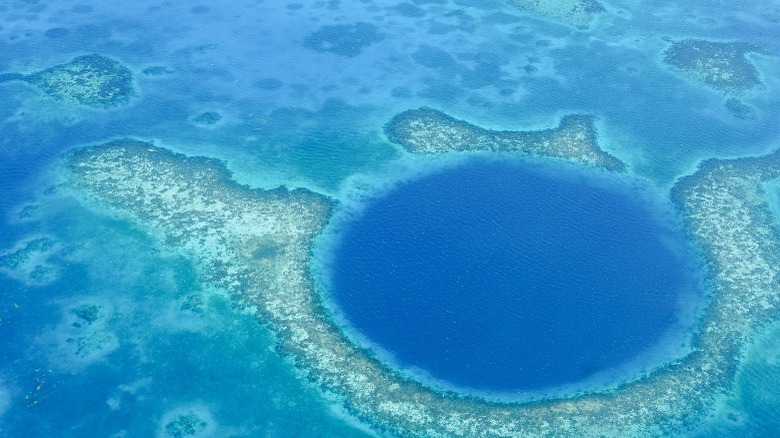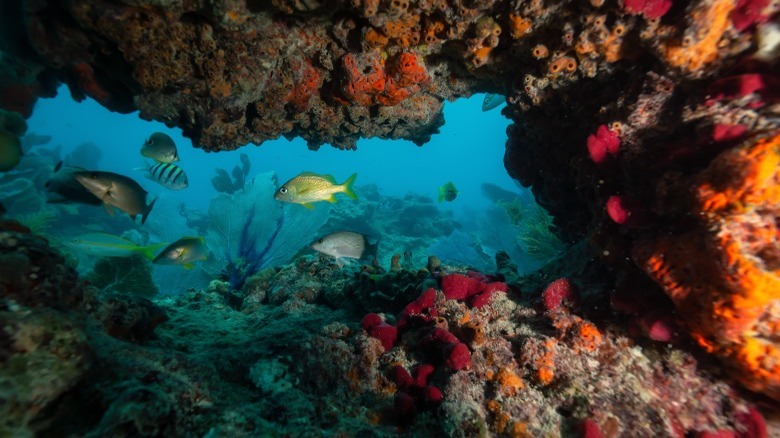The Best Snorkeling Destinations In The World
You don't need to be a licensed diving expert to explore our planet's underwater worlds. In fact, many of the most diverse and life-filled ecosystems are located only a few feet from our oceans' surfaces, making them easily accessible using nothing more than a simple snorkel. Additionally, snorkeling is one of the greatest beginner-friendly activities and is widely available when traveling, per Sandals. With only essential equipment, anyone with a practical knowledge of swimming basics can spend hundreds of hours floating about the world's marine habitats while getting up close and personal with some of the planet's most exotic species.
Not only is snorkeling a fun pastime, but it also happens to be one of the most adventurous activities travelers can engage in. According to World Atlas, 95% of our ocean floor remains largely unexplored, and some of the planet's last greatest mysteries are just waiting to be discovered under its aquatic surface. From hidden away lakes on isolated islands to vast coral reefs spanning several miles, these are the most vibrant and biologically diverse ecosystems that double as some of the best snorkeling destinations in the world.
1. Great Barrier Reef, Australia
Let's start with the world's most obvious snorkeling destination — the Great Barrier Reef. Located just off the shores of Australia's east coast in the southwest Pacific Ocean, the Great Barrier Reef is not only the largest and the most famous reef, but it also happens to be the world's youngest, with its modern formation occurring approximately 9,500 years ago, according to BGR Biology. However, despite its relatively brief presence on our globe, the Great Barrier Reef is one of the most biodiverse aquatic ecosystems to be found anywhere on the planet. As per the World Wildlife Fund, it is home to over 1,500 species of fish, 30 species of marine mammals, and six species of turtles.
Designated a UNESCO World Heritage Area, the entire reef system is comprised of over 2,500 individual reefs, many of which predate the Great Barrier Reef, and each boasts a unique and colorful ecosystem just waiting to be explored. The earliest evidence of coral reefs thriving along the region's continental shelf occurred 15,000 years ago, and it has since grown and evolved into the Great Barrier Reef we know today. With so many variable habitats comprising its over 21,000 square miles, the Great Barrier Reef is home to some of the planet's most celebrated and exotic marine species. When combining its ecological abundance and easy accessibility near the Australian coast, it is easy to understand why the Great Barrier Reef is consistently considered one of the best snorkeling destinations in the world for beginners and enthusiasts alike.
2. Raja Ampat, Indonesia
Occupying the northern corner of Papua, Indonesia, Raja Ampat experiences far less traffic than other snorkeling destinations. As a result, the coral reefs in the region are protected from the downfalls of over-tourism and boast some of the most pristine aquatic communities in the world. An archipelago of over 1,400 small islands, Raja Ampat features the most biologically diverse aquatic environment on the planet. In fact, according to the Raja Ampat Biodiversity Nature Resort, the protected waters of the region are home to over 1,700 fish species, 700 varieties of mollusks, approximately 30 marine mammals, and nearly 80% of the planet's coral species.
And thanks to the significantly under-trafficked nature of the Papua region in Indonesia, visitors to this cradle of nature can explore the vibrant waters without the oversaturation of tourists that can often occur in similar corners of paradise. With such a rich biodiversity and variability, Raja Ampat promises a myriad of adventures, and each of its many snorkel spots offers unique experiences for visitors. Snorkelers can spend years floating along its surface-based habitats and only see a fraction of what these bountiful waters provide. Whether your first snorkel trip or your thousandth, Raja Ampat is a fantastic location for exploring the widest variety of aquatic species, all within a single destination.
3. Galapagos Islands, Ecuador
Known for its biological diversity and evolution unhindered by the influences of humankind, the Galapagos Islands feature life below the waves just as colorful and varied as the creatures that roam its extraordinary lands. From sea turtles and penguins to humpback whales and sea lions, snorkelers to the Galapagos have the opportunity to swim with some of the most exotic aquatic creatures in the world.
Located approximately 600 miles from continental Ecuador, the Galapagos Islands is a chain of 19 volcanic islands whose extreme isolation has made them an environmentalist's daydream and a UNESCO World Heritage Site. Surrounding these magnanimous islands is approximately 133,000 square miles of the Galapagos Marine Reserve, home to more than 2,900 marine species. The islands' protected aquatic area is comprised of several habitats, ranging from underwater volcanoes and mountain ranges to vibrant coral reefs and colonies. Occupying these ecosystems is a massive variety of life, including several species of whales, dolphins, sea turtles, rays, and sharks.
One of the best aspects of snorkeling in the Galapagos Islands is that visitors do not need to stray far from the shorelines to visit these vibrant creatures. In fact, many of the best snorkeling spots in the Galapagos Islands can be accessed from nearby beaches, offering an engaging experience for veterans and beginners alike.
4. Komodo National Park, Indonesia
While Komodo National Park may have garnered its fame as a UNESCO World Heritage Site for being the sole natural habitat for Komodo Dragons in the wild, this small protected island of Indonesia's Lesser Sunda chain is also home to some of the country's most abundant aquatic ecosystems. Established in 1980 to protect its eponymous species, Komodo National Park is home to daily tidal flows that offer some of the world's most pristine conditions for aquatic life. As a result, the park's waters are home to 1,000 fish species and one of the most vibrant spanning coral reefs to be found anywhere, per the Manta Rhei Dive Center.
What's even better for potential snorkelers to Komodo National Park is that the waters surrounding the island are crystal clear, allowing for unhindered visibility to the colorful habitats only a few feet below the surface of the water. Occupying these bright underwater abodes are numerous fish species and aquatic mammals, including clownfish, frogfish, and two ray species. While there are many fantastic snorkeling spots around the island, many are located in areas with a heavy current. While these areas should only be visited by experienced snorkelers, others, such as Siaba Besar, are beginner friendly and offer diverse ecosystems teeming with sea life.
5. Bora Bora, French Polynesia
A majestic volcanic island surrounded by crystal clear waters and vibrant coral reefs, the conditions in Bora Bora are some of the best in the world for snorkeling with the native aquatic life. Featuring warm water temperatures throughout the year, the coral reefs surrounding the island are home to hundreds of fish species, including sting rays, black tip reef sharks, and humpback whales, per Adventure Life. The beautiful azure lagoon surrounding the island is protected by a barrier reef and offers calm, warm waters year-round, providing optimal snorkeling conditions for swimmers of all skill levels. Considered to be one of the most beautiful islands in the world, Bora Bora is traditionally a favorite destination amongst couples and honeymooners and features plenty of verdant forests and white sand beaches.
What makes this French Polynesian island such a fantastic snorkeling destination? According to the Bora Bora Island Guide, many of the region's best snorkeling hot spots can be reached directly from the island's coastline. As a result, visitors can pair a snorkeling adventure through one of the world's most aquatic water habitats with an intrepid hike through one of the world's most beautiful islands and beaches. While Bora Bora is known as a honeymoon hotspot, the beautiful waters of the island's lagoon are teeming with colorful aquatic life and beckon couples and solo travelers alike for one of the best snorkeling experiences on the planet.
6. Isla del Cocos, Costa Rica
Isolated in the Pacific Ocean, 340 miles from the Costa Rican mainland, Cocos Island National Park is a UNESCO World Heritage Site and is home to some of Central America's most biologically diverse underwater ecosystems. Nicknamed "Treasure Island," thanks to its historical use as a pirate cove, Isla del Cocos is the only island with a tropical rainforest in the eastern Pacific Ocean, with an abundance of life spreading out into its surrounding waters. The island's unique location as the first point of contact for the Northern Equatorial Counter-Current has established the region as the epicenter for many aquatic environments, and the island has become an important location for studying associated biological processes.
According to Go Visit Costa Rica, the Cocos Island National Park boasts some of the most biodiverse waters and is world-renowned among snorkelers and divers as one of the best destinations on the planet for observing large marine species in their natural habitats. These aquatic species include various types of local sharks, tuna, rays, dolphins, and much more.
While the entire Isla del Coco is surrounded by beautiful clear waters and colorful reef-filled ecosystems, certain spots offer different snorkeling experiences for travelers with various skill levels. Whether a strong swimmer or a young family seeking their first experience of the underwater world, there are plenty of fantastic snorkeling spots near "Treasure Island" for everybody.
7. Abu Dabbab Bay, Marsa Alam, Egypt
Aquatic life may not be the first thing you think of when imagining Egypt, but the waters of Adu Dabbab Bay are home to some of the most vibrant marine species in the world, per Snorkel Around the World. The bay faces a beautiful sand beach in the southern Red Sea and is home to hundreds of colorful fish, spotted sea turtles, dugongs, and sting rays. It is one of the most unique snorkeling experiences on our planet.
Located along the Egyptian coastline about 30 km north of Maras Alam, Adu Dabbab Bay consists of a central sprawling seagrass bed and is engulfed by coral reefs on either end. This variability results in a diverse aquatic ecosystem in what is a relatively compressed environment, allowing for a greater level of exploration in a limited area.
In the extensive seagrass meadows, snorkelers can observe green sea turtles and marine mammals, including dugongs, which rest on the soft grassy sea floor. After swimming with these popular large species, snorkelers can wade their way over to the bay's bordering coral reefs. Here they will discover colorful marine habitats, home to a massive variety of fish, including moray eels, lionfish, and the exotic bluespotted ribbon tail ray.
8. Baa Atoll, The Maldives
The atolls that comprise the Maldives are world-renowned for their aquatic life and diving center. Still, amongst its plethora of fantastic marine ecosystems, no destination compares to the Baa Atoll, the country's premier snorkeling hot spot. Designated as a UNESCO Biosphere Reserve in 2011, the Baa Atoll is home to some of the most colorful aquatic organisms in the Indian Ocean, including species of marine turtles, whale sharks, manta rays, and fish.
Covering 139,000 hectares, the Baa Atoll features plenty of diversity. It is home to several aquatic habitats, including coral reefs, islands, sea grass beds, and mangroves. However, while there are plenty of great snorkeling spots around the atoll, Hanifaru Bay is the most popular for experiencing the region's biodiversity. According to Visit Maldives, Hanifaru Bay is home to one of the Earth's most significant single gatherings of manta rays.
While the Baa Atoll offers excellent year-round snorkeling, there are seasons when specific aquatic life is more abundant. For example, June to November is one of the best overall times to visit the site and features the region's greatest season of marine diversity, per Forbes. However, snorkelers visiting at this time may also experience heavy crowding during the tourist season. Regardless of when you choose to visit, the Baa Atoll offers visitors plenty of underwater sea life year-round and is a must-visit destination for exploring the exotic ecosystems of the Indian Ocean.
9. Togean Island, Indonesia
When it comes to countries with fantastic snorkeling destinations and marine biodiversity, Indonesia is unmatched, with no less than three snorkeling hot spots featured on this list. And of these three wonderous ecosystems, the Togean Islands are home to one of the most unique aquatic species in the world — stingerless jellyfish. Isolated in Mariona Lake on one of the Togean's remote islands for thousands of years, these amazing jellyfish have reproduced and evolved with no natural predator, and as such, have had no need for developing a stinger. The result is a surreal experience floating through a tranquil lake riddled with thousands of these peculiar creatures.
According to Itinari, only seven of these mysterious jellyfish populations exist in the world, with the most notable being in Palau and Kakaban Island. However, the Togean Island population stands above the rest as one of the world's best snorkeling destinations, thanks to the massive variety of aquatic species that occupy the surrounding waters as well. As a large archipelago in the Gulf of Tomini in the northern region of Sulawesi, each of the Togean's 56 islands is surrounded by colorful reefs, easily accessible from the shores of your resort's own private beach. Native species of these exotic waters include dugongs, green sea turtles, and hammerhead sharks, per Stingy Nomads.
10. Hanauma Bay, Oahu, Hawaii
The epitome of tropical destinations, Hawaii is home to some of the most transparent waters and vibrant marine species in the Pacific Ocean. And while fantastic snorkeling spots are available throughout the archipelago's eight major islands, the Hanauma Bay Nature Preserve is home to one of the most significant concentrations of biodiversity in marine life in the entire world, according to the Hanauma Bay State Park's official website.
As the sole beach on Oahu dedicated to snorkeling, Hanauma Bay is the best place in Hawaii for getting up close and personal with the local sea life. The vibrant coral reefs offer habitation to native species of butterflyfish, parrotfish, green sea turtles, and many other varieties of marine creatures, per Love O'ahu. Additionally, Hanauma Bay's reefs begin only a few meters from the beach's shore, which, combined with the bay's protected waters, result in optimal swimming conditions perfect for snorkelers of all swimming levels. Whether visiting Hawaii with your little ones or as an expert on all things sea life, Hanauma Bay offers a safe experience while providing one of the most unique aquatic experiences anywhere in the world.
11. Belize Barrier Reef, Belize
Spanning 185 miles from Bacalar Chico to the Bay of Honduras, the Belize Barrier Reef is the second-largest reef in the world and is home to hundreds of aquatic species, per UNESCO. Lining Belize's entire coastline, the Belize Barrier Reef features a massive diversity of marine habitats, including coral atolls, offshore cayes, coastal lagoons, mangrove forests, estuaries, and a variety of reefs. The result is one of the greatest concentrations of biodiversity anywhere in the world, with several species of sea turtles, rays, eels, dolphins, sharks, and manatees residing in the reef's warm waters, per Island Expeditions.
However, while the water's biodiversity makes the reef an ideal snorkeling destination, what truly sets the Belize Barrier Reef apart as a unique site is the presence of the Great Blue Hole — a 125-meter-deep sinkhole first formed over 150,000 years ago, according to Marine Insight. While scuba gear is required to explore the depths of the Great Blue Hole, snorkelers will find plenty of aquatic life in the first few meters of sea level surrounding the landmark in the region known as Lighthouse Reef. Here swimmers will encounter some of the reef's most tropical species, including nurse sharks, giant groupers, and several varieties of reef sharks.
12. Florida Keys, USA
Florida Keys is home to some of North America's most abundant marine life. With several reefs and protected marine parks, the Florida Keys feature miles of pristine ecosystems separating the Atlantic Ocean from the Gulf of Mexico. With a wide variety of marine habitats, many aquatic species reside in the waters surrounding the Florida Keys. According the the Florida Keys National Marine Sanctuary, these species include several varieties of sea mammals, sponges, fish, and other sea life. To explore these exotic creatures, snorkelers can float their way through the region's aquatic ecosystems, which range from extensive seagrass beds and coral reefs to mangroves and other preserved underwater abodes.
Spanning the 3,800 square nautical miles encompassing the island chain, the Florida Keys National Sanctuary is home to most of the region's native aquatic inhabitants. While snorkelers can explore the area independently, several tours are available for a guided experience through the water's vibrant habitats, making this tropical region perfect for snorkelers of all experience levels. The Florida Keys' easy accessibility for North American travelers and year-round warm waters make it a spectacular destination for beginners seeking their first immersion into the many wonders of our planet's underwater worlds.
